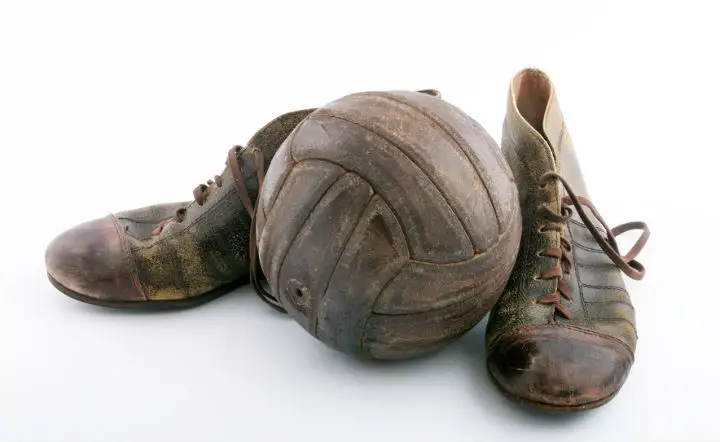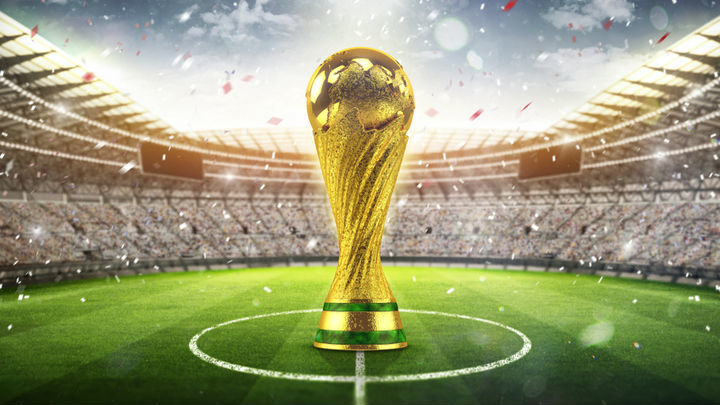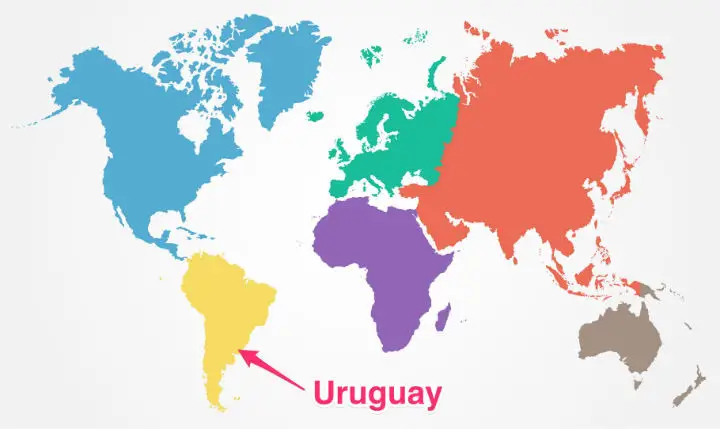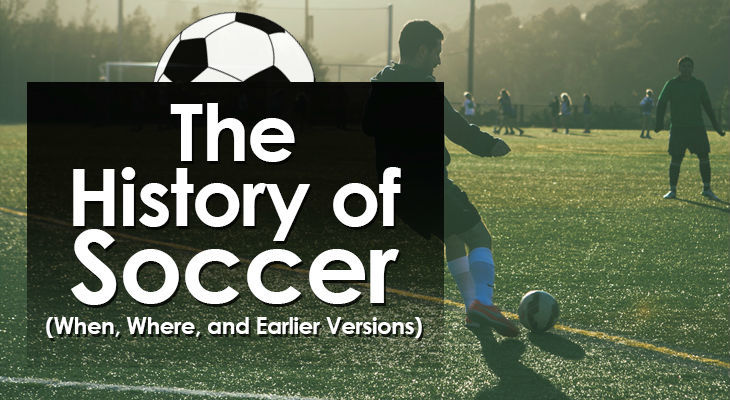The History of Soccer (When, Where, and Earlier Versions)
For the most watched and played sport on the planet, you would find it surprisingly hard to find a soccer fan who actually knows the history of soccer.
Many of us can reel off reams of statistics, share hundreds of facts about our favorite teams, and endlessly debate whether Ronaldo is actually better than Messi…
But ask any soccer fan about the origin of soccer and odds are you’ll be met with a blank stare and vague answer.
So, just when was soccer invented and where did soccer originate?
While many variations of the sport have appeared throughout history, is it even possible to pinpoint the birth of modern soccer?
Where does the home of soccer actually lie?
How has soccer evolved over time?
While many elements regarding soccer’s history can be debated and discussed, there is a general consensus as to how the sport has evolved over the years.
Let’s take a look at the history of soccer to see when and where it originated and how it became the global sport that it is today.
When Was Soccer Invented
Soccer has a long and varied history which means we need to travel back through the millennia to find the origins of the game.
As with most inventions, various adaptations usually occur before the accepted standard version appears and this also rings true for soccer.
The first variation of soccer that appeared and has been backed up by scientific evidence was in China in the third and second Century BC.

This means that the roots of the beautiful game appeared over two millennia ago!
This early soccer ancestor was played during the Han Dynasty and the scientific proof comes in the form of a military manual that details how the game was set up.
Ts’u Chu (or Cuju) as it was known had many similarities with modern soccer as a ball was aimed at a goal and other players were allowed to impede or tackle the shooting player.
Made out of feathers, hair, and leather, the ball was similar to some of the early balls that players such as Sir Stanley Matthews would have used.
While the goal did have a net, it measured only 30 or 40 centimetres in width and was suspended from bamboo poles high above the ground.
Unlike some other early soccer variations, players were not allowed to use their hands.
While earlier versions of games similar to soccer are assumed to have existed, scientific documentation has yet been found to back up some of the competing claims.
FIFA itself recognises Ts’u Chu (which literally means ‘kick ball’) as the precursor to the modern game.
From then on, various forms of soccer-like games appeared in different cultures and societies around the world.
Early Versions of the Beautiful Game
From these early beginnings, new variations and forms of soccer quickly flourished.
However, the rules involved were very different from the game that we know and love today.
As there is no accepted ‘official history’ of soccer, there is some debate as to which early sports influenced the birth of modern soccer.
Another early version, for example, was harpastum that was played in the Roman Empire.

While it was a ball game and we have various documents detailing its existence, little is known about the exact rules of the game.
It is generally accepted, however, that it was a very violent sport.
While there were elements of soccer present, it is possibly more accurate to say that it was akin to an early form of rugby.
In this sport, the ball was smaller and harder than a modern-day soccer ball and the linguistic roots of the name harpastum derive from the Latin verb ‘to carry away’ which again indicates a similarity to rugby.
Dating back to 200 AD, the sport does have some links and similarities to soccer.
A Roman tombstone, for example, includes an image of a harpastum which looks very much like a modern-day soccer ball.
Where Did Soccer Originate
As we have already seen, the earliest widely accepted ancestor of soccer (Ts’u Chu) appeared in the 3rd – 2nd Century BC in China.
While this is an early variation, it does not tell us where the modern game originated and how it evolved from its humble beginnings into the mega-popular sport that it is today.
For this we have the Romans to thank as it is they who took harpastum from the streets of Rome to the meadows and fields of England.

Over time, the game became massively popular with the common people and this early version of soccer spread around the country.
Back then whole villages took part and the game was often brutally violent and occasionally resulted in the deaths of some of the participants. Property was also often damaged in the huge brawls that were almost a characteristic of the game.
As a consequence, authorities attempted to ban the sport at various times.
In 1314, for example, this early form of soccer was banned in London and people risked imprisonment if they were caught playing it.
Various English monarchs through the ages also banned the sport as they believed the game’s popularity distracted the soldiers from practicing their archery skills.
Needless to say, the bans (thankfully) never stuck and over time the sport flourished.
Various forms originated in different parts of Europe with one popular example being the Calcio on show in Renaissance Florence.
This early hybrid of soccer and rugby is still played in the city today with Il Calcio Storico attracting hordes of tourists every year who revel in the brutal yet entertaining game!
An important moment in soccer history was the introduction of this early form of soccer to the English public school system.
While the sport itself would be banned on and off for over 500 years, it would be the recreational use of the game in schools that would ultimately result in the soccer we know today.
Because of this, it is widely acknowledged that Great Britain is the home of soccer and where the modern-day sport originated from.
The Birth of the Modern Game of Soccer
Over the centuries and millennia there have been a multitude of different ball sports, each with their own rules and variations.
After the introduction of harpastum to the British Isles, various local differences also appeared as there were no formal rules to the sport.
In the end, soccer, rugby, and Gaelic football would emerge from the mess that was the origins of soccer.
Before rules were agreed upon, violence plagued the sport and kicking the ball or your opponents was equally acceptable.
With the number of players on each team varying depending on who was around and no area demarcated for the pitch, early versions of the game were incredibly chaotic.
How long the match went on for was also open to interpretation and the ball was often only one in name rather than shape.
Although originally adopted in schools as a good form of exercise, the modern-day sport partially owes its existence to these institutions.

In 1848 Cambridge University drew up a set of rules for the game which included goal kicks and throw-ins and prevented players from running with the ball in their hands.
While other institutions and clubs drafted their own rules around this time, the general consensus was that a standard set of rules should be formalised.
As a consequence, the Football Association was formed in 1863.
Within eight years, a remarkable fifty clubs had joined the association and soccer as we know it was well on its way to being finalised.
While rules continued to be debated and decided upon (as they still are today), the Football Association’s establishment helped overall to further the development of a standard set of rules.
Uniforms were agreed upon as was the type of ball to be used, how long the matches should go on for, as well as the actual sizes of the pitches they played on.
The FA Cup, the oldest soccer competition in the world, would first take place in 1872 and by 1888 a league had been formed.
The popularity of these soccer matches drew huge numbers of spectators to the games and the professionalisation of the game quickly followed around this time when the first soccer players were financially rewarded for their efforts.
From then on, soccer would only become more and more popular.
And due to Britain’s influence in the world, the game quickly spread like wildfire overseas.
FIFA, the First World Cup, and the Laws of the Game

With the astonishing growth of the sport occurring over such a short period of time, it should come as no surprise that a number of tournaments and competitions quickly sprung up around the world.
After the establishment of the Football Association in England, Scotland, Wales, and Ireland quickly followed suit.
They were then followed by the Netherlands and Denmark in 1889 and a whole host of different countries over the next ten years; ranging from Argentina and Uruguay to Hungary and New Zealand.
Their respective football associations then helped to spread the rules of the game and establish leagues in the varying countries.
While a number of international matches had already taken place between England and Scotland, the rapid spread of the game meant that a central body would be needed to manage and coordinate the sport.
Which is why FIFA was formed in 1904.
FIFA originally consisted of only seven members but this would quickly change as numerous countries joined and swelled the organisation’s ranks.
Soccer was included for the first time as an Olympic sport in 1908 and this predated the first World Cup by just over twenty years.
Soccer truly became international around this time as countries as far as South Africa, Chile, and the United States all joined FIFA before 1915.
The organisation’s early days and continued growth would suffer a setback though as the outbreak of the First World War threatened to derail the game’s international expansion.
In 1930, however, the first World Cup would be hosted by Uruguay.

The South American country was chosen as it was celebrating its centenary and it had just retained its Olympic soccer crown.
Thirteen teams entered the competition with the participants consisting of teams from South America, Europe, and North America.
The hosts Uruguay would eventually end up winning the first World Cup by defeating Argentina 4-2 in the final.
History had been made and the success of the tournament paved the way for the competition to be held every four years.
Back then, the world was a much bigger place and the transportation methods of the day meant that it took the players from Europe over two weeks to arrive in Uruguay for the tournament.
Many of the modern-day game’s rules and regulations would be developed and presented to the members of FIFA between 1937 and 1938 when Stanley Rous compiled the Laws of the Game.
These rules were very successful in terms of shaping the modern game and they were only recently revised in 1997.
With the establishment of FIFA, the creation of the Laws of the Game, and a successful World Cup having taken place; soccer was ready to take on the world and become the most popular sport on the planet.
History of Soccer Conclusion
Since the first World Cup, soccer has transformed dramatically over the decades.
Now more than ever, changes are occurring at incredible speed due to the sport’s increasing commercialisation in a globalised world.
Over the last two decades, for example, the World Cup has been hosted in Asia and Africa for the first time and FIFA has faced increasing criticism over its management of the international game despite its attempts to take soccer to every corner of the globe.
While competitions such as the Champions League, La Liga, and the Premier League dominate media coverage of the sport around the world, soccer continues to evolve and progress.
From the game’s humble origins in ancient China through to the modern-day sport in the British Isles, soccer has proved to be a lasting and incredibly popular sport; loved by billions around the globe.
What is certain, though, is that some teams will rise as others fall, new stars will constantly emerge, and the game will progress through new tactical variations and formations as each generation adds to the history of soccer.

